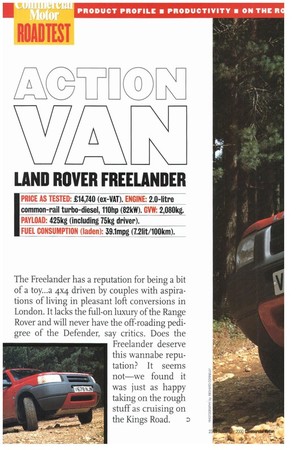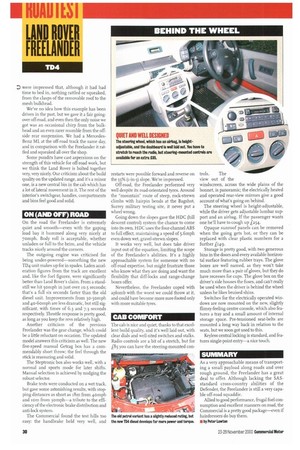LAND ROVER FREELANDER
Page 28

Page 30

Page 32

If you've noticed an error in this article please click here to report it so we can fix it.
IPRICE AS TESTED: E14,740 (ex-VAT). ENGINE: 2.0-litre common-rail turbo-diesel, 110hp (82kW). GVW: 2,080kg. PAYLOAD: 425kg (including 75kg driver). FUEL CONSUMPTION (laden): 39.1mpg (7.21it/100km). n he Freelander was launched in
1998 to instant acclaim. Land
T
Rover boasted it was employing 250 extra staff and keeping production lines running through the night to cope with the huge demand. Much of this demand,
up to 80%, according to Land Rover, came from the saloon car set looking for something a little different—something a little more "lifestyle" to take the kids to school in.
Thus the nasty comments about the Freelander. It won't cope off-road, they say; it's for yuppies and hairdressers—or worse, yuppie hairdressers with horseboxes. But Land Rover insists the Freelander has the same true-grit off-roading spirit as its elder and more dedicated country brother, the Defender, whose credentials it is unwise to doubt.
So hidden among all the hype, anti-hype and deluded car drivers with dreams of commuting right into the city along green lanes lurks a Commercial version of the Freelander success story. Launched last year, it has come to account for a fair proportion of all Freelander sales, and Land Rover expects that success to continue.
And why shouldn't it? It can be a true working vehicle, complete with tie-down points, load-bay liner and removable roof sections. Removable roof sections? Read on...
PRODUCT PROFILE
The Freelander range has just been expanded and updated from its 1.8-litre K-Series petrol and 2.0-litre normally aspirated diesel origins.
The 1.8 engine remains, with slightly reduced ratings of ir5hp (86kW) and r6oNm (ii8lbft), but it has been joined by a 2.5-litre V6 petrol option with peak power of 175hp (r3rkW), and a 2.0-titre common-rail diesel featuring a variable-nozzle turbo for better response at lower revs.
The new four-pot TD4 diesel develops significantly more power and torque than the previous unit, with irohp (82kW) on tap at 4,000rpm and 26oNm (i921bft) at 1,75orpm. That's an increase of i6hp and 5oNm, available 25orpm lower in the range. Despite its name, the TD4 is not simply a smaller version of the excellent TD5 seen in the Defender, but a brand-new design from BMW.
The manual five-speed box is now sourced from Getrag, while TD4 buyers have the option of the five-speed Steptronic, as used on the V6, for L936 (ex-VAT).
The entire Freelander range comes with ABS, ETC, HDC and EBD as standard, which translates as help with braking, accelerating, cornering and going down hills. Body types are split into the five-door estate and the threedoor models with roll-up softback or removable hardback—a blacked-out version of this is standard for the Commercial variant.
, The basic price for the Commercial has fallen from 115,421 to £14,740. A lengthy options list includes air conditioning for £638, a chequer-plate floor for £239 and remote stereo controls for £85. The standard bulkhead is a three-quarter-height mesh type; a heavy-duty version will set you back £294.
Warranty is for three years/60,00o miles (with no distance limit in the first year), including pan-European roadside assistance.
We tested the old diesel first, both onand off-road, and then tried the new V6 with Steptronic gearshift. Finally we took the TD4 to the test track and gave it a laden run around our Kent test route for light vehicles, so this test is as comprehensive as you're likely to get.
PRODUCTIVITY
A lot of manufacturers shy away from claiming consumption figures for their range—but not Land Rover, it boasts a consumption of 37.2mpg for the TD4, compared with the old diesel's 36.6mpg. Optimistic? Hardly--around our route the TD4 returned 39.T mpg. The outgoing diesel returned 34.8mpg—and remember, we were running fully laden.
Compared with a Ford Ranger or Land Rover Defender, the Freelander's payload of 425kg (after taking into account our nominal 75kg driver) is nothing to write home about. To be fair, it's on a par with direct competitors like the Mitsubishi Shogun and Vauxhall Frontera, and only 2 ookg or so below vehicles weighing half a tonne more. Axle tolerance is a useful 140kg.
The load volume is some 1.2m3, but with a fairly lofty loading height of 65ornm. The space is certainly usable, with four robust tiedown points as standard. The mesh bulkhead seems pretty effective, and can be upgraded.
The Freelander features a removable roof section at the rear which converts the vehicle into a pickup of sorts. Release four catches, lift off the roof (a single-handed job, with a little practice) and the heated wash/wipe rear window retracts itself into the rear door. Voila! Two variants for the price of one.
This might seem a little "Action Man" to some, but it does have some practical value, offering the chuck-in flexibility of a pickup with the potential to protect valuable cargo from the elements (and thieving hands).
Longevity is an important part of any vehicle's productivity, but it's difficult to appraise. Too many manufacturers supply test vehicles with very few miles on the clock— some are not even run in—but the old diesel model we tried had 7,500 miles under its belt. We
were impressed that, although it had had time to bed in, nothing rattled or squeaked, from the clasps of the removable roof to the mesh bulkhead.
We've no idea how this example has been driven in the past, but we gave it a fair goingover off-road, and even then the only noise we got was an occasional chirp from the bulkhead and an even rarer mumble from the offside rear suspension. We had a MercedesBenz ML at the off-road track the same day, and in comparison with the Freelander it rattled and squeaked all over the shop.
Some pundits have cast aspersions on the strength of this vehicle for off-road work, but we think the Land Rover is bolted together very, very nicely. Our criticism about the build quality on the updated range, and it's a minor one, is a new central bin in the cab which has a lot of lateral movement in it. The rest of the interior's switchgear, handles, compartments and bins feel good and solid.
ON AND OFF ROAD
On the road the Freelander is extremely quiet and smooth—even with the gaping load bay it hummed along very nicely at ompb. Body roll is acceptable, whether unladen or full to the brim, and the vehicle tracks nicely around the corners.
The outgoing engine was criticised for being under-powered—something the new TD4 unit makes up for in spades. Laden acceleration figures from the track are excellent and, like the fuel figures, were significantly better than Land Rover's claim. From a standstill we hit 50mph in just over 10.5 seconds; that's a full six seconds faster than the old diesel unit. Improvements from 30-50mph and 40-60 mph are less dramatic, but still significant, with times of 6.3 and 7.3 seconds respectively. Throttle response is pretty good, as long as you keep the revs relatively high.
Another criticism of the previous Freelander was the gear change, which could be a little reluctant on occasion. The updated model answers this criticism as well. The new five-speed manual Getrag box has a commendably short throw; the feel through the stick is reassuring and solid.
The Steptronic box also works well, with a normal and sports mode for later shifts. Manual selection is achieved by nudging the robust selector.
Brake tests were conducted on a wet track, but gave some astonishing results, with stopping distances as short as igm from ,I.ornph and join from 30mph—a tribute to the efficiency of the electronic brake distribution and anti-lock system.
The Commercial found the test hills too easy: the handbrake held very well, and restarts were possible forward and reverse on the 33% (I-in-3) slope. We're impressed.
Off-road, the Freelander performed very well despite its road-orientated tyres. Around the "mountain' route of steep, rock-strewn climbs with hairpin bends at the Bagshot, Surrey military testing site, it never put a wheel wrong.
Going down the slopes gave the H DC (hill descent control) system the chance to come into its own. HDC uses the four-channel ABS to full effect, maintaining a speed of 5.6mph even down wet, gravel-strewn slopes.
It works very well, but does take driver input out of the equation, limiting the scope of the Freelander's abilities. It's a highly approachable system for someone• with no off-road expertise, but might frustrate those who know what they are doing and want the flexibility that diff-locks and range-change boxes offer.
Nevertheless, the Freelander coped with aplomb with the worst we could throw at it, and could have become more sure-footed only with more suitable tyres.
CAB COMFORT
The cab is nice and quiet, thanks to that excellent build quality, and it's well laid out, with clear dials and well-sited switches and stalks. Radio controls are a bit of a stretch, but for £85 you can have the steering-mounted con trols. The view out of the windscreen, across the wide plains of the bonnet, is panoramic; the electrically heated and operated rear-view mirrors give a good account of what's going on behind.
The steering wheel is height-adjustable, while the driver gets adjustable lumbar support and an airbag. If the passenger wants one he'll have to cough up £254.
Opaque sunroof panels can be removed when the going gets hot, or they can be replaced with clear plastic numbers for a further £49.
Storage is pretty good, with two generous bins in the doors and every available horizontal surface featuring rubber trays. The glove boxes are well named, as they won't take much more than a pair of gloves, but they do have recesses for cups. The glove box on the driver's side houses the fuses, and can't really be used when the driver is behind the wheel unless he likes bruised shins.
Switches for the electrically operated windows are now mounted on the new, slightly flimsy-feeling centre console, which also features a tray and a small amount of internal storage space. Pre-tensioned seat-belts are mounted a long way back in relation to the seats, but we soon got used to this.
Keyless central locking is standard, and features single-point entry—a nice touch.
SUMMARY
As a very approachable means of transporting a small payload along roads and over rough ground, the Freelander has a great deal to offer. Although lacking the SASstandard cross-country abilities of the Defender, the Freelander is still a very capable off-road squaddie.
Allied to good performance, frugal fuel consumption and excellent manners on road, the Commercial is a pretty good package—even if hairdressers do buy them.
by Peter Lawton




































































































